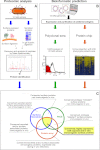Multi high-throughput approach for highly selective identification of vaccine candidates: the Group A Streptococcus case
- PMID: 22286755
- PMCID: PMC3433891
- DOI: 10.1074/mcp.M111.015693
Multi high-throughput approach for highly selective identification of vaccine candidates: the Group A Streptococcus case
Abstract
We propose an experimental strategy for highly accurate selection of candidates for bacterial vaccines without using in vitro and/or in vivo protection assays. Starting from the observation that efficacious vaccines are constituted by conserved, surface-associated and/or secreted components, the strategy contemplates the parallel application of three high throughput technologies, i.e. mass spectrometry-based proteomics, protein array, and flow-cytometry analysis, to identify this category of proteins, and is based on the assumption that the antigens identified by all three technologies are the protective ones. When we tested this strategy for Group A Streptococcus, we selected a total of 40 proteins, of which only six identified by all three approaches. When the 40 proteins were tested in a mouse model, only six were found to be protective and five of these belonged to the group of antigens in common to the three technologies. Finally, a combination of three protective antigens conferred broad protection against a panel of four different Group A Streptococcus strains. This approach may find general application as an accelerated and highly accurate path to bacterial vaccine discovery.
Conflict of interest statement
Conflict of interest: G. G., I. M., N. N. and J. L. T. are holders of company stock options. G. B., M. M., M. D., E. C., F. F., A. M., P. D., E. S., V. P., R. J., M. M. and M. S. are employed by the Company that funded the work. All other authors report no potential conflicts.
Figures





References
-
- Maione D., Margarit I., Rinaudo C. D., Masignani V., Mora M., Scarselli M., Tettelin H., Brettoni C., Iacobini E. T., Rosini R., D'Agostino N., Miorin L., Buccato S., Mariani M., Galli G., Nogarotto R., Dei V. N., Vegni F., Fraser C., Mancuso G., Teti G., Madoff L. C., Paoletti L. C., Rappuoli R., Kasper D. L., Telford J. L., Grandi G. (2005) Identification of a universal group B streptococcus vaccine by multiple genome screen. Science 309, 148–150 - PMC - PubMed
-
- Pizza M., Scarlato V., Masignani V., Giuliani M. M., Arico B., Comanducci M., Jennings G. T., Baldi L., Bartolini E., Capecchi B., Galeotti C. L., Luzzi E., Manetti R., Marchetti E., Mora M., Nuti S., Ratti G., Santini L., Savino S., Scarselli M., Storni E., Zuo P., Broeker M., Hundt E., Knapp B., Blair E., Mason T., Tettelin H., eacute, Hood D. W., Jeffries A. C., Saunders N. J., Granoff D. M., Venter J. C., Moxon E. R., Grandi G., Rappuoli R. (2000) Identification of vaccine candidates against serogroup B meningococcus by whole-genome sequencing. Science 287, 1816–1820 - PubMed
-
- Doro F., Liberatori S., Rodriguez-Ortega M. J., Rinaudo C. D., Rosini R., Mora M., Scarselli M., Altindis E., D'Aurizio R., Stella M., Margarit I., Maione D., Telford J. L., Norais N., Grandi G. (2009) Surfome analysis as a fast track to vaccine discovery: identification of a novel protective antigen for group B streptococcus hypervirulent strain COH1. Mol. Cell. Proteomics 8, 1728–1737 - PMC - PubMed
-
- Rodriguez-Ortega M. J., Norais N., Bensi G., Liberatori S., Capo S., Mora M., Scarselli M., Doro F., Ferrari G., Garaguso I., Maggi T., Neumann A., Covre A., Telford J. L., Grandi G. (2006) Characterization and identification of vaccine candidate proteins through analysis of the group A streptococcus surface proteome. Nat. Biotechnol. 24, 191–197 - PubMed
Publication types
MeSH terms
Substances
LinkOut - more resources
Full Text Sources
Other Literature Sources
Medical

